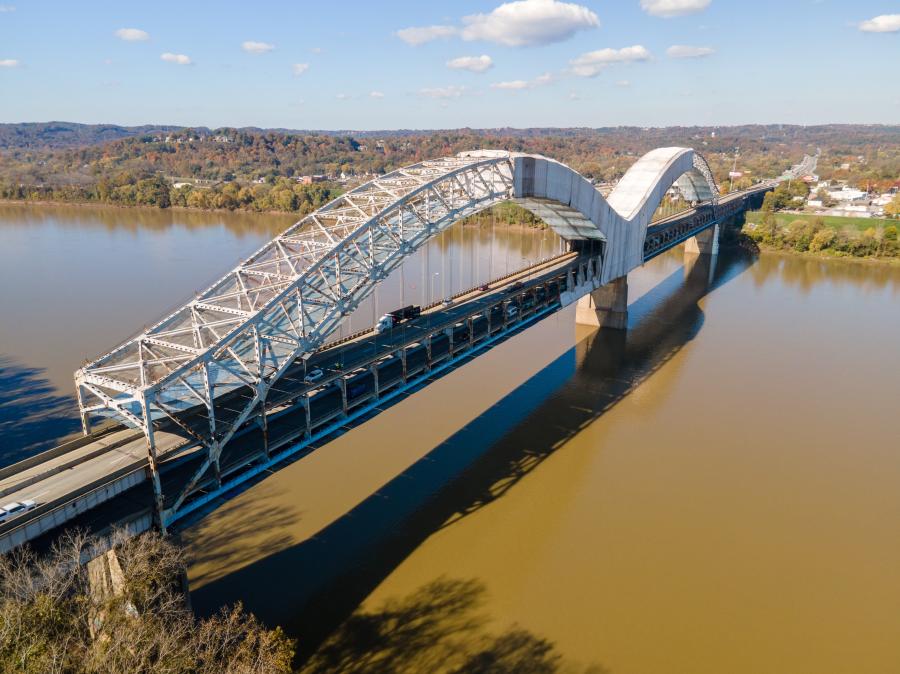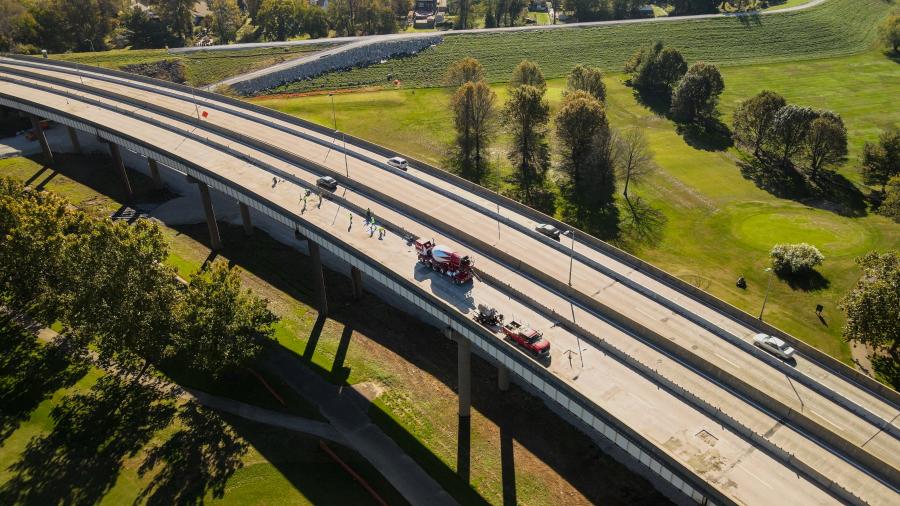The double-decked design of the bridge, also known for its arches, makes for tight space, particularly on the lower deck where the deck above prohibits movement.
Fifty-nine years after opening, the iconic Sherman Minton Bridge carrying I-64 and U.S. 150 traffic over the Ohio River between Louisville, Ky., and New Albany, Ind., is in need of structural repairs. But the challenges of rehabbing a double decked bridge over a major body of water are many, not the least of which are traffic and space.
Teams on the $137 million bi-state project have come up with some interesting ways to overcome those challenges — with limited road closures.
"IDOT [Indiana Department of Transportation] and KYTC [Kentucky Transportation Cabinet] developed a maintenance traffic plan that minimizes traffic impact during construction," said Vince Martini Jr., senior project manager of Kokosing Construction Company Inc. "The existing I-64 is three lanes in each direction and we have to maintain two lanes in each direction for most of the project. Essentially, this leaves us two lanes to work on in each phase."
The new traffic configuration went into phase one in September, routing one eastbound lane — typically on the lower deck — through contraflow into the upper westbound lanes, separated by barrier walls to ensure safety for drivers.
The contract allows for full closure of the bridge for only 54 days out of 843. But there are provisions allowing the contractor to do additional lane closures when crews need additional room.
"Our contract allows us to reduce traffic down to one lane at night. In this first phase, we will close the eastbound lane that remains on the eastbound deck and still maintain one eastbound lane. They are above us. We will use the closed eastbound lane to get delivery trucks and materials, etc., into and out of our work area."
Work on the bridge includes structural steel repairs; replacing bridge decks and hanger cables; rehab work on the substructure; drainage repairs; and new lighting and painting. There is no substructure work occurring in the river other than navigation clearance gauges that need to be repainted.
The double-decked design of the bridge, also known for its arches, makes for tight space, particularly on the lower deck where the deck above prohibits movement. That has called for at least one piece of specialized equipment.
"For the rebuilding of the decks, a lot of times we use a concrete pump to get the concrete from the truck up onto the deck," Martini said. "In those cases, pumps may sit below the bridge. This project is using what we call a concrete plow. Essentially, it sits up on the deck you are getting ready to pour. It shuttles the concrete from one of the lanes and brings it out onto the deck we are going to pour. It gives us the means to transfer concrete from the truck and over the rails, the same rails that are used by the Bidwell bridge finishing machine. We can run the concrete buggy to place concrete wherever we need it. This will be a first for me." This also is the first time Martini has used a particular style of hydrodemolition machine. They'll use it on the concrete piers holding up the bridge beams.
"We purchased an Aquajet 410 V," Martini said. "It's a remote-control water blaster. Basically, the high pressure will actually remove the concrete from the surface of the piers. We will then reface the piers with new concrete."
In addition to the specialized equipment, crews are working with numerous manlifts and telescoping boom forklifts. Minor earthwork will be necessary to move the eastbound lanes across the westbound lanes.
"We're using crossovers to ensure safe traffic flow. In Phase 1, this involves building a temporary lane through the median to take the left eastbound lane and move it to the left westbound lane. We need to build an embankment so we can take the eastbound across the median."
The bridge rehab is a design-build/best value project that was launched publicly in August 2018. Public involvement has been an important component of the project from the start, involving outreach to the general public, local officials, business leaders and community and environmental justice advisory groups to gather input on their preferences. Ultimately, this input led to the development of the low impact traffic maintenance plan approved by the Federal Highway Administration in fall 2020. Construction is slated to be substantially finished in fall 2023 and fully in spring 2024.
Here are some quick facts from the Sherman Minton Renewal webpage:
Overview
- Major bridge rehabilitation
- Will add up to 30 years of life to the bridge
- Replace or refurbish Sherman Minton and Kentucky approach decks
- Rehabilitate or replace structural steel elements and hanger cables
- New lighting
- Drainage repairs
- Paint steel components
Sherman Minton Bridge
- First interstate bridge in Louisville
- Opened in 1962
- Unique double-decked design
- Carries six lanes of traffic (I-64 and U.S. 150)
- Carries about 70,000 vehicles daily
- Long-term repairs needed to extend the life of the bridge
Environmental Process
- Study is required by law for federally funded projects
- Public involvement is a key part of the study
- Analyzed temporary social, economic and environmental impacts
- Considered ways to avoid, minimize or mitigate temporary impacts
- Worked with state, local and federal officials
Timeline
- Construction approach approved in fall 2020
- Complete contract procurement, selected design-build/best value contractor in winter 2020
- Construction began late summer 2021
- Construction completed in three years
Funding
- Fully funded through federal and state highway funds
- Indiana and Kentucky will share the cost of the work
- There are no plans to toll the Sherman Minton Bridge CEG
Lori Tobias
Lori Tobias is a journalist of more years than she cares to count, most recently as a staff writer for The Oregonian and previously as a columnist and features writer for the Rocky Mountain News. She is the author of the memoir, Storm Beat - A Journalist Reports from the Oregon Coast, and the novel Wander, winner of the Nancy Pearl Literary Award in 2017. She has freelanced for numerous publications, including The New York Times, The Denver Post, Alaska Airlines in-flight, Natural Home, Spotlight Germany, Vegetarian Times and the Miami Herald. She is an avid reader, enjoys kayaking, traveling and exploring the Oregon Coast where she lives with her husband Chan and rescue pups, Gus and Lily.
Read more from Lori Tobias here.
Today's top stories
















